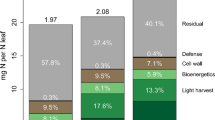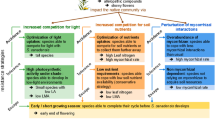Abstract
Extended leaf phenology (ELP) may commonly drive invasion in Eastern deciduous forests of North America. ELP may confer an advantage in competition, and may interact with other invasion factors. For example, ELP may interact with allelopathy (release of toxins) if exposure to seasonal light influences allelochemical production. Here, we examine ELP and its interaction with glucosinolate (allelochemical) production in invasive garlic mustard (Alliaria petiolata). To test ELP’s role in invasion, garlic mustard was grown in monoculture or polyculture with native species under natural and extended shade regimes. Consistent with an ELP invasion mechanism, garlic mustard survival was higher in natural shade than extended shade, although invader biomass and native responses did not differ between light treatments. While garlic mustard leaf glucosinolate concentration was higher in natural than extended shade during September of its first year, this pattern did not hold at three other time points. Stronger support for the role of ELP in driving garlic mustard invasion emerged from direct manipulation of germination phenology, with higher garlic mustard survival and biomass resulting when germination occurred earlier in the season. Analysis of allelochemical production across eight populations of garlic mustard revealed significant inter-population variation in glucosinolate responses to light availability. Overall, results of these three experiments indicate that ELP may facilitate garlic mustard’s survival in invaded communities. We did not find strong evidence for a synergistic relationship between ELP and allelopathic potential, possibly due to high levels of inter-population variation in the relationship between allelopathy and light.




Similar content being viewed by others
References
Anderson RC, Dhillion SS, Kelley TM (1996) Aspects of the ecology of an invasive plant, garlic mustard (Alliaria petiolata), in central Illinois. Restor Ecol 4:181–191. doi:10.1111/j.1526-100X.1996.tb00118.x
Barto EK, Powell JR, Cipollini D (2010) How novel are the chemical weapons of garlic mustard in North American forest understories? Biol Invasions 12:3465–3471. doi:10.1007/s10530-010-9744-5
Barto EK, Antunes PM, Stinson K, Koch AM, Klironomos JN, Cipollini D (2011) Differences in arbuscular mycorrhizal fungal communities associated with sugar maple seedlings in and outside of invaded garlic mustard forest patches. Biol Invasions 13:2755–2762. doi:10.1007/s10530-011-9945-6
Bouchereau A, ClossaisBesnard N, Bensaoud A, Leport L, Renard M (1996) Water stress effects on rapeseed quality. Eur J Agron 5:19–30. doi:10.1016/s1161-0301(96)02005-9
Brundrett M, Kendrick B (1990) The roots and mycorrhizas of herbaceous woodland plants. 1. Quantitative aspects of morphology. New Phytol 114:457–468. doi:10.1111/j.1469-8137.1990.tb00414.x
Cantor A, Hale A, Aaron J, Traw MB, Kalisz S (2011) Low allelochemical concentrations detected in garlic mustard-invaded forest soils inhibit fungal growth and AMF spore germination. Biol Invasions 13:3015–3025. doi:10.1007/s10530-011-9986-x
Cipollini D (2002) Variation in the expression of chemical defenses in Alliaria petiolata (Brassicaceae) in the field and common garden. Am J Bot 89:1422–1430. doi:10.3732/ajb.89.9.1422
Dickie IA, Koide RT, Steiner KC (2002) Influences of established trees on mycorrhizas, nutrition, and growth of Quercus rubra seedlings. Ecol Monogr 72:505–521. doi:10.2307/3100054
Engelhardt MJ, Anderson RC (2011) Phenological niche separation of an invasive species Alliaria petiolata. J Torrey Bot Soc 138:418–433
Fridley JD (2012) Extended leaf phenology and the autumn niche in deciduous forest invasions. Nature 485:359–362
Hale AN, Tonsor SJ, Kalisz S (2011) Testing the mutualism disruption hypothesis: physiological mechanisms for invasion of intact perennial plant communities. Ecosphere. doi:10.1890/es11-00136.1
Harrington RA, Brown BJ, Reich PB (1989) Ecophysiology of exotic and native shrubs in southern Wisconsin. 1. Relationhip of leaf characteristics, resource availability, and phenology to seasonal patterns of carbon gain. Oecologia 80:356–367. doi:10.1007/bf00379037
Kalisz S, Spigler RB, Horvitz CC (2014) In a long-term experimental demography study, excluding ungulates reversed invader’s explosive population growth rate and restored natives. Proc Natl Acad Sci USA. doi:10.1073/pnas.1310121111
Karagiannidis N, Thomidis T, Lazari D, Panou-Filotheou E, Karagiannidou C (2011) Effect of three Greek arbuscular mycorrhizal fungi in improving the growth, nutrient concentration, and production of essential oils of oregano and mint plants. Sci Hortic 129:329–334. doi:10.1016/j.scienta.2011.03.043
Lankau RA, Nuzzo V, Spyreas G, Davis AS (2009) Evolutionary limits ameliorate the negative impact of an invasive plant. Proc Natl Acad Sci USA 106:15362–15367. doi:10.1073/Pnas.0905446106
Lewis KC, Bazzaz FA, Liao Q, Orians CM (2006) Geographic patterns of herbivory and resource allocation to defense, growth, and reproduction in an invasive biennial, Alliaria petiolata. Oecologia 148:384–395. doi:10.1007/s00442-006-0380-9
Lovelock CE, Miller R (2002) Heterogeneity in inoculum potential and effectiveness of arbuscular mycorrhizal fungi. Ecology 83:823–832. doi:10.2307/3071884
McEwan RW, Birchfield MK, Schoergendorfer A (2009) Leaf phenology and freeze tolerance of the invasive shrub Amur honeysuckle and potential native competitors. J Torrey Bot Soc 136:212–220
Muller C (2009) The role of glucosinolates in plant invasiveness. Phytochem Rev 8:227–242. doi:10.1007/S11101-008-9115-3
Niu HB, Liu WX, Wan FH, Liu B (2007) An invasive aster (Ageratina adenophora) invades and dominates forest understories in China: altered soil microbial communities facilitate the invader and inhibit natives. Plant Soil 294:73–85. doi:10.1007/s11104-007-9230-8
Pinheiro J, Bates D, DebRoy S, Sarkar D, Team TRC (2009) nlme: linear and nonlinear mixed effects models, R Package version 3.1-96 edn
R_Development_Core_Team (2009) R: a language and environment for statistical computing. R Foundation for Statistical Computing, Vienna
Rosa EAS, Heaney RK, Rego FC, Fenwick GR (1994) The variation of glucosinolate concentration during a single day in young plants of Brassica-oleracea var acephala and capitata. J Sci Food Agric 66:457–463. doi:10.1002/jsfa.2740660406
Rosa EAS, Heaney RK, Portas CAM, Fenwick GR (1996) Changes in glucosinolate concentrations in Brassica crops (B-oleracea and B-napus) throughout growing seasons. J Sci Food Agric 71:237–244. doi:10.1002/(sici)1097-0010(199606)71:2<237:aid-jsfa574>3.0.co;2-p
Schreiner RP, Koide RT (1993) Mustards, mustard oils and mycorrhizas. New Phytol 123:107–113
Smith LM (2013) Extended leaf phenology in deciduous forest invaders: mechanisms of impact on native communities. J Veg Sci. doi:10.1111/jvs.12087
Smith LM, Reynolds HL (2014) Light, allelopathy, and post-mortem invasive impact of garlic mustard on native forest understory species. Biol Invasions 16:1131–1144. doi:10.1007/s10530-013-0567-z
Stinson KA, Seidler TG (2014) Physiological constraints on the spread of Alliaria petiolata populations in Massachusetts. Ecosphere. doi:10.1890/es14-00164.1
Stinson KA et al (2006) Invasive plant suppresses the growth of native tree seedlings by disrupting belowground mutualisms. PLoS Biol 4:727–731. doi:10.1371/journal.pbio.0040140
Swearingen J, Slattery B, Reshetiloff K, Zwicker S (2010) Plant Invaders of Mid-Atlantic Natural Areas 4th ed., 4 edn. National Park Service and U.S. Fish and Wildlife Service, Washington, DC
Tholen JT, Shifeng S, Truscott RJW (1989) The thymol method for glucosinolate determination. J Sci Food Agric 49:157–165
Vaughn SF, Berhow MA (1999) Allelochemicals isolated from tissues of the invasive weed garlic mustard (Alliaria petiolata). J Chem Ecol 25:2495–2504. doi:10.1023/a:1020874124645
Warcup JH (1988) Mycorrhizal associations and seedling development in australian Lobelioideae (Campanulaceae). Aust J Bot 36:461–472. doi:10.1071/bt9880461
Warnes GR et al (2009) gplots: Various R programming tools for plotting data. R package version 2(7):3
Zenni RD, Nunez MA (2013) The elephant in the room: the role of failed invasions in understanding invasion biology. Oikos 122:801–815. doi:10.1111/j.1600-0706.2012.00254.x
Acknowledgments
Thanks to Therese Burkhard and Gerald Smith for extensive field and laboratory assistance throughout the duration of these experiments, and to Stephanie Dickinson of the Indiana University Statistical Consulting Center for assistance with data analysis. Thanks to Richard Lankau for contributing garlic mustard seed of known allelopathic potential that was used in establishing and verifying glucosinolate analysis protocols. Thanks to NSF DEB-1310750 Doctoral Dissertation Improvement Grant, Sigma Xi Grant in Aid of Research, Indiana Native Plant and Wildflower Society, Indiana Academy of Sciences Senior Research Grant, the Indiana University Department of Biology, and contributors to the #SciFund Challenge project ‘Alien Invaders: Armed and Dangerous’ for financial support for these experiments.
Conflict of interest
The authors declare that they have no conflict of interest.
Author information
Authors and Affiliations
Corresponding author
Rights and permissions
About this article
Cite this article
Smith, L.M., Reynolds, H.L. Extended leaf phenology, allelopathy, and inter-population variation influence invasion success of an understory forest herb. Biol Invasions 17, 2299–2313 (2015). https://doi.org/10.1007/s10530-015-0876-5
Received:
Accepted:
Published:
Issue Date:
DOI: https://doi.org/10.1007/s10530-015-0876-5




